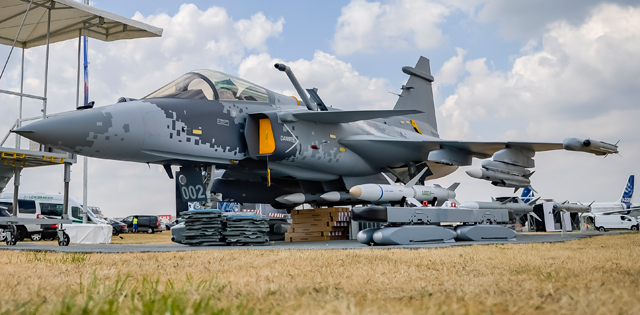Saab is confident that the second and third test examples of its Gripen E will fly soon, as it continues development work with the first aircraft.
The second and third test jets, designated 39-9 and 39-10, will “fly soon,” says Jonas Hjelm, senior vice president and head of aeronautics at the Swedish manufacturer. While they won’t join the test programme at exactly the same time, at this time in 2019 they will both be part of it, he says.
Meanwhile, Saab’s first test aircraft, 39-8, has flown with newly-added external stores: five pylons produced by Ruag, as well as two IRIS-T air-to-air missiles on its wingtip stations. The Gripen E first flew in June 2017.
“Gripen flew as expected and we are very pleased with the flight test results,” says Hjelm. “During the flight, the aircraft carried out a number of actions to verify the flying and handling qualities of the aircraft with this extended configuration.”

BillyPix
The company says that each Gripen E comes with eight pylons. These can be used for fuel, sensors, or weapons.
Hjelm adds that the emphasis with 39-8’s flight testing has been on the Gripen E’s handling characteristics. As new jets enter the testing programme, additional systems, such as electronic warfare, radar, and a Link 16 datalink will be introduced.
Hjelm however did not say when the two-seat Gripen F, which is part of Brazil’s order for 36 Gripens, will conduct its first flight.
He stressed that the advent of the single-seat Gripen E and two-seat Gripen F does not mean that the existing Gripen C and D have reached the end of their lives, and the original version of the fighter still possess a substantial growth path. Indeed, the development of the more advanced variant feeds continued work on C and D platform, he says.
When asked about Saab’s view on so-called sixth generation fighter programmes, which are likely to see cross border efforts to develop advanced fighters or unmanned combat vehicles, Hjelm said that Saab is already deep into futuristic work with the Gripen E development.
“We are willing to talk to everyone in Europe and even outside about next generation fighters. Gripen E will be part of that discussion.”
He adds that the industry’s conversations about UCAVs have subsided somewhat in recent years, mainly because of philosophical concerns about unmanned systems. Longer term, he expects interest in this area to grow again, but with a greater emphasis on optionally manned platforms.
Get all the coverage from the Farnborough air show on our dedicated event page
Source: FlightGlobal.com


























